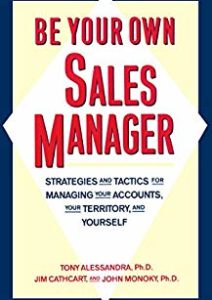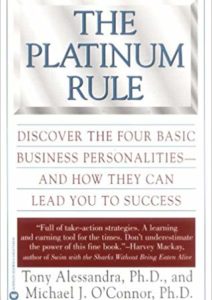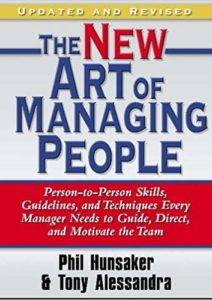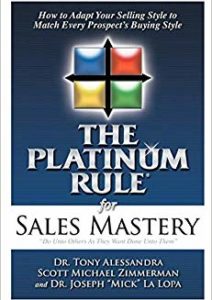If, as someone once said, tact is the radar of the mind, then practicing DISC theory can be a valuable tune-up of your antenna.
Indeed, DISC can have a positive effect on almost every aspect of managing. With each of the four behavioral styles, there’s a different way to communicate and delegate tasks to them, compliment and correct them, to motivate and counsel them.
That’s more than we can get to in this brief article. But I do want to explain how to increase your compatibility and effectiveness with all your employees.
Where Does Your Power Come From?
First, recognize that your power to influence employees springs from two sources: “positional power” and “personal power.” Positional power is just what it sounds like–you’re the CEO, the department head, the regional sales manager, and a certain amount of power comes from being anointed by the hierarchy.
But personal power comes from earning it, from developing it. Positional power is a starting point for influencing someone but the best you will get from your employees is compliance. But it’s personal power that turns mere compliance into real commitment, cooperation, and collaboration.
Employees have gained added clout in recent decades. Court decisions combined with more enlightened theories of management have had the effect of giving more say to the rank-and-file. In fact, it’s now believed that a leader can’t really lead until he or she is genuinely accepted by the led.
Thus, personal power–in essence, your skill in dealing with people–is increasingly crucial to you and your organization.
In short, if you honor your employees’ individuality, their essential difference, they’ll feel like they’re on a winning team and will work harder, better for you. But you must empower them rather than just seeking power over them.
You can do that by learning to listen, observe, and talk to them. And then adapting so they’ll feel important, wanted. That’s DISC put into action. Do that and you’ll see less tension and fewer conflicts and have a more effective, motivated workforce.
High Performance Leadership Development: The “Best” DISC Style
Remember, the best leader isn’t someone with a particular behavioral style, or even some ideal blend of styles. Instead, the best leader is someone who realizes what a job or task requires–and then does it! That means working well with all of the personality styles in all sorts of situations.
In fact, as firms re-structure and put new emphasis on teamwork, leaders who understand behavioral styles will have a leg up. As situational leaders, they may wish to act in their natural style, using their intrinsic strengths. At other times, they may choose to adapt to others, using DISC principles. Or, when they sense a serious clash of styles, they may wish to pick a third person to handle a certain situation.
Yet another option open to the manager is to change the work environment–say, realign a worker’s duties, alter deadlines, or revamp priorities–to allow employees to play to their strengths. Most managers today agree that you can’t mandate productivity.
A friend of ours, for example, employed a strong High ‘C’ Conscientious Style as bookkeeper/office manager. She was terrific at that job, but when the boss had to leave the office, the High ‘C’ Conscientious Style also had to answer the phone, and that’s where the trouble began. Complaint after complaint piled up about the bookkeeper’s brusqueness. Finally, her boss phoned in, pretending to be a customer, and was shocked how abruptly she was treated.
“I just hate it when customers call,” the bookkeeper later conceded. “They interrupt what I’m doing.” Though a good worker, she wasn’t cut out to deal with the phone. Needless to say, the boss got somebody else to answer the phone, and everybody was happier–the boss, bookkeeper, and the customers!
For any organization to run best, it probably needs all four styles. You can’t just say ‘We’re a sales organization, so we need all High ‘I’ Influencing Styles. Or ‘we’re an engineering outfit, so we just need results-oriented High ‘D’ Dominance Styles and High ‘C’ Conscientious Styles.” You need all four types, but you need them in the right spots.
In all cases, though, you, the manager, should be very aware of your style and how it can affect others. Being conscious of the extremes of your style will allow you to become more than just a boss but a leader. Often, supervisors who make a study of their style in the workplace also see improved relationships at home and in social settings. “Wow!” they’ll say as they see for the first time how others view them, “that’s what my spouse has been telling me all these years.”
Whatever your primary style, you can choose to make it more palatable. Here are some ways a manager performing as an effective situational leader can round off some of the sharper edges of his or her personal style:
High Performance Leadership for “High D Styles” (Dominance)
Ratchet down a notch or two! Keep in mind that others have feelings and that your hard-charging, know-it-all style can make your subordinates feel inadequate and often resentful.
Accept that mistakes will occur, and try to temper justice with mercy. You might even joke about errors you make, rather than trying to always project a super-human image.
High ‘D’ Dominance Styles can encourage growth in others in at least two ways. One, by praising them when they do something well. Secondly, by giving them some authority and then staying out of their way so they can use it. Whatever you lose in control, you’re likely to gain in commitment and improved staff competency.
Try not to be quite so bossy! Ask others’ opinions and maybe–though this is radical for a High ‘D’ Dominance Style–even plan some collaborative actions.
High Performance Leadership for “High I Styles” (Influence)
Your people depend on you not just for ideas, but for coordination, too. So anything you can do to become more organized–making lists, keeping your calendar current, prioritizing goals–will pay big dividends for you and them.
Nothing’s so dispiriting as to see the boss drop the ball on important matters. So, remember: If you fail to follow-up, procrastinate on tough decisions, or make pledges you don’t keep, your employees will lose faith. Even though you don’t do those things purposely, they’ll see you as letting them down. Your charm and warmth can’t fully compensate for unreliability.
Also, come to grips with the fact that conflicts are going to occur. Try to deal with them up front, not sweep them under the rug. In addition, organize your time better and keep your socializing in balance with your tasks.
High Performance Leadership for “High S Styles” (Steadiness)
You’re probably a well-liked boss. Your goal should be to become a more effective, well-liked boss.
Learn to stretch a little, taking on more, or different, duties and trying to accomplish them more quickly. You may want to be more assertive as well as more open about your thoughts and feelings. Experiment with a little risk, a little change.
Being sensitive to your employees’ feelings is one of your greatest strengths. But you must seek a middle ground between that and being knocked off balance by the first negative comment or action that comes your way.
High Performance Leadership for “High C Styles” (Conscientious)
Your high standards are a two-edged sword. Your employees are inspired by your quest for excellence, but often they feel frustrated because they can never quite seem to please you.
One of the best things you can do is lessen and soften your criticism, spoken or unspoken. You can seem so stern sometimes!
Ease up on your need to control. Walk around and spend more time with the troops, chatting up people at the water cooler or in the lunchroom.
Wake up to the fact that you can have high standards without requiring perfection in each instance. That’ll take a load off your shoulders–and off your employees, too.
Whatever your style, being adaptable can help you to build bridges to your employees and make them feel valued. By learning to best respond to their interests and concerns, their strengths and weaknesses, you can get the most from your people as well as leave them more satisfied.
Pipeliner CRM empowers sales managers to be high-powered leaders. Get your free trial of Pipeliner CRM now.
















Comments